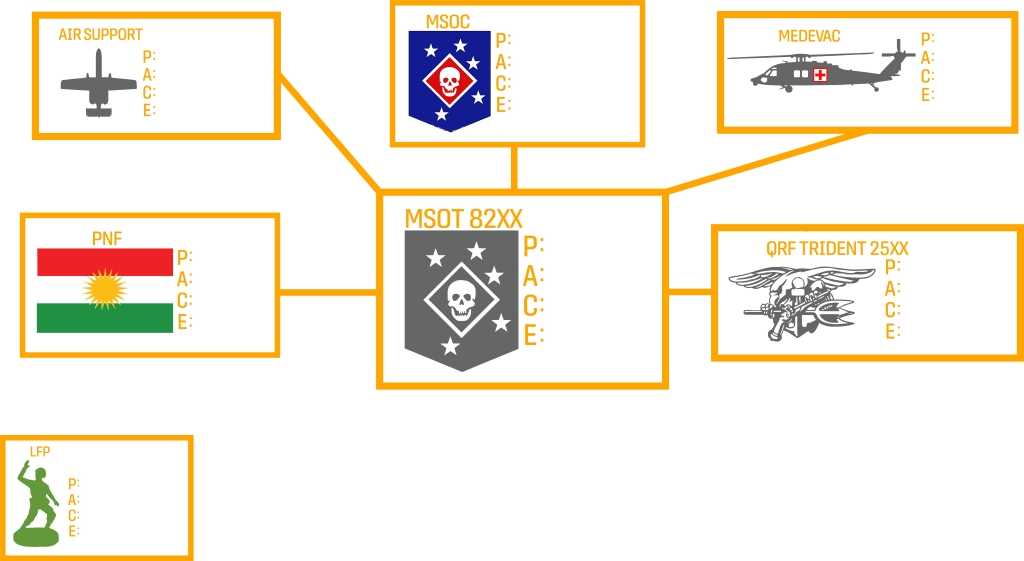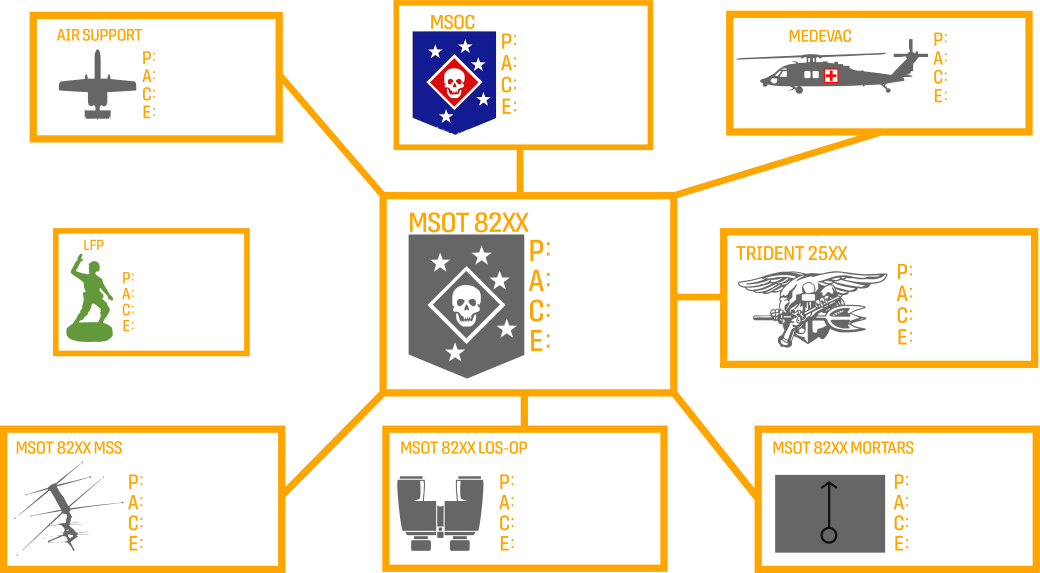
As I mentioned in the last PACE planning article, PACE planning can get complicated quickly. In this article, we will apply the first key point of PACE planning creation and implementation to our example operation. Before we do that, let’s review the three key points and the example operation from the first article:
3 Key Points
1) PACE planning is phase-specific, and every mission will have multiple PACE plans.
2) You establish PACE plans for partners or other friendly forces to reach you and for team internal communications.
3) Determining what communication method is your Primary, Alternate, Contingency, and Emergency is based on a balance of 3 things:
-How secure the communication method is.
-How your communication method performs in your environment.
-How reliable and convenient your communication method is to use.
Example Operation
Marine Special Operations Team (MSOT) 82XX will insert using a Ground Assault Force (GAF) via a Local National partner force to known Observation Point (OP) at grid 18S-TD-XXXXX-XXXXX to conduct defensive operations on the Forward Line of Troops (FLOT) via organic 120mm and 81mm mortars supported by organic small Unmanned Aerial Systems (sUAS) and organic Line of Sight (LOS) surveillance personnel for 96 hours. MSOT 82XX will have fixed-wing air support during all troop movements and during periods of darkness. Trident 25XX will be MSOT 82XX’s Quick Reaction Force (QRF) for the duration of the mission. MSOT 82XX is expected to relay significant information to the Marine Special Operations Company (MSOC) in real time and maintain communication windows every 4 hours.
The reason why I am referencing this operation as our example is because it is complex regarding communication planning. There are a lot of adjacent units and moving parts. Will we, as civilians, ever have the equipment necessary, or the need, to plan communications for an operation like this? Probably not. But learning and practicing more complexly is beneficial.
Now that we have those refreshed let’s apply key point number 1 to our example and figure out where a PACE plan should be in this operation. To begin, let’s break this “Fragmentary order” (FRAGO) down, line by line.
Mission Phases: Movement (Phases 1 and 3)
We can break this operation down into three different phases. To keep this simple, we will call Phase 1 “Insertion,” Phase 2 “Actions On,” and Phase 3 “Extraction,” with both Insertion and extraction being considered “movement” phases.
Movement (Phases 1 and 3)
MSOT 82XX is described as the main effort, and they will use an assortment of ground vehicles to insert into this operation. While moving, a Local National partner force will be escorting them. MSOT 82XX will also have air support on station during all their movements and during periods of darkness, with Trident 25XX being their QRF. Lastly, we see that MSOT 82XX will need to pass all vital information and conduct a comms check with higher headquarters every 4 hours during all phases of the operation. While on the objective, MSOT 82XX will not only need to maintain communications with their QRF element, air support at night, and higher headquarters but also within the team internally between their three different elements. Although it is not listed in the “FRAGO,” it is always implied that some emergency communication planning be established for lost friendlies and for reaching the Medical Evacuation (MEDEVAC) bird on station.
As you can see, MSOT 82XX has a lot of people they need to talk to just in the movement phases (phases 1 and 3) of this operation. MSOT 82XX will need to establish seven different PACE plans: One for team internal comms, one for the Local National partner force, one for their QRF element (TRIDENT 25XX), one for air support, one for higher headquarters, one for MEDEVAC, and one for their lost friendlies plan.
Now that we have established where a PACE plan needs to be in the operation’s movement phases let’s figure out where a PACE plan needs to be during the “Actions On” phase, AKA phase 2.
Actions On (Phase 2)
During the Actions On phase, MSOT 82XX will need to maintain their communications with their QRF, air support at night, the MEDEVAC bird, lost friendlies plan, and higher headquarters. These PACE plans may change depending on the equipment capabilities in the vehicles. In most cases, stationary communication methods are better than mobile communication methods. In this case, MSOT 82XX will need to adjust their PACE plan to reach higher headquarters, air support, MEDEVAC, and QRF once they arrive at the known Observation Point.
As the “FRAGO” stated, their Local National partner force is only in support during phases 1 & 3, so MSOT 82XX does not need a PACE plan for them during this phase. The “FRAGO” makes clear that MSOT 82XX will have three separate elements, each in a different location, during phase 2. There will need to be a PACE plan established from each of these elements to the Ground Force Commander (GFC). He will generally be located with MSOT 82XX’s organic sUAS systems, but we will still make a PACE plan for the team members at that location to help ensure he is only getting necessary traffic. So, in phase 2, the MSOT will have a total of 8 different PACE plans.
Summary
To simplify the above, here is a summary and visual representation of the PACE plans needed during each operation phase.
Phase 1 & 3 (Insertion & Extraction):
PACE plan 1: MSOT -> MSOT (team internal communications)
PACE plan 2: MSOT -> Local National partner force
PACE plan 3: MSOT -> Trident Team 25XX (QRF)
PACE plan 4: MSOT -> Fixed-wing air support
PACE plan 5: MSOT -> MSOC (higher headquarters communications)
PACE plan 6: MSOT -> MEDEVAC
PACE plan 7: Lost friendly plan
Phase 2 (Actions On):
PACE plan 1: MSOT -> Trident Team 25XX (QRF)
PACE plan 2: MSOT -> Fixed-wing air support
PACE plan 3: MSOT -> MSOC (higher headquarters)
PACE plan 4: MSOT -> MEDEVAC
PACE plan 5: Lost friendly plan
PACE plan 6: GFC (Ground Force Commander, AKA MSOT’s team leader) -> MSOT Mortar element
PACE plan 7: GCF -> MSOT MSS (Mission Support Site, AKA MSOT’s organic sUAS location)
PACE plan 8: GFC -> MSOT LOS Observation element
As you can see, some of these PACE plans change during different operation phases. This is because communication capabilities are generally limited during movements. So, when MSOT 82XX arrives at the known Observation Point, the PACE plan for reaching some adjacent friendlies will change since their communication capabilities have improved. We can add more PACE plans to accommodate the transitions between phases, but you all get the point. However, those transitory PACE plans are important. For example, suppose a team member gets hurt while attempting to load onto an aircraft before the start of an operation in the dead of night, and there are no PACE plan considerations. In that case, there is a good chance his teammates could not hear him over the aircraft’s engines or see him because of how dark it is. It’s just something to consider.
I hope this article will help you all better understand the need for multiple PACE plans in your operations. In the next T&E newsletter, we will apply key point number 2 to each PACE plan in each operation phase to determine which unit will establish the PACE plan. Also, we will be laying out all the available communication methods and capabilities available to MSOT 82XX, some information on the terrain, and some information on what electronic warfare (EW) capabilities our enemy has.
If you have any questions or comments about PACE planning, send them over to us at team@trex-arms.com


